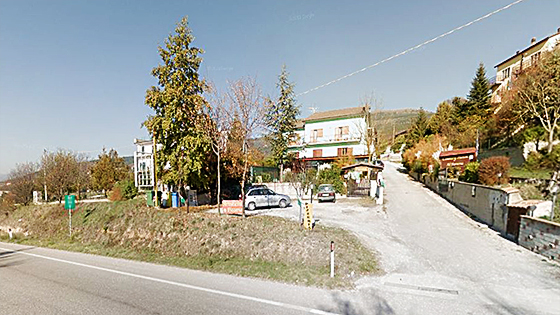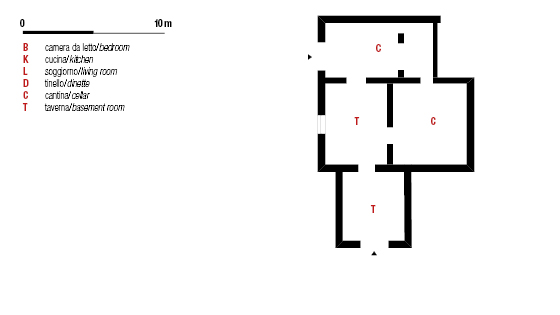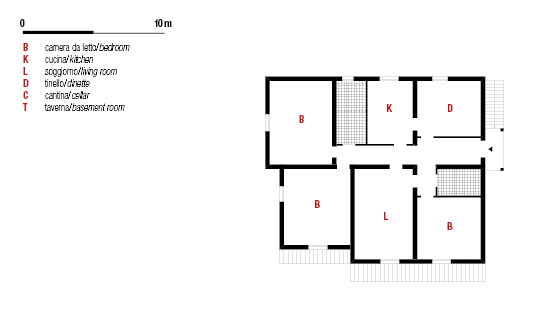2014/11/16
L’Aquila – tornare a casa/returning home
Un doppio rientro: scelte di vita in controtendenza e pratiche insediative degli anni Settanta alla prova del post-terremoto
Claudia Faraone
Mimetizzata da alberi ormai trentennali, la casa dove vivono Franco e Giusi da poco più di sei mesi è esemplare del principio insediativo ricorrente nelle espansioni dei paesi medio-piccoli della provincia di L’Aquila e in generale dei contesti montani abruzzesi. Una casa isolata su lotto con un grande spazio aperto tutt’intorno con cui è coordinata funzionalmente: il ricovero attrezzi, la dependance ombreggiata per l’estate, il deposito della legna per la stufa d’inverno, il parcheggio per la macchina, l’orto e il giardino.
La casa si colloca nella seconda periferia di Poggio Picenze, paese di poco più di 1.000 abitanti a 15 km da L’Aquila che dagli anni Cinquanta ha conosciuto un dimezzamento dei propri abitanti, ma che negli ultimi anni si è andato pian piano ripopolando. Tra i nuovi cittadini ci sono Franco e la sua famiglia: originario del paese, dopo aver vissuto 14 anni nel nord Italia è tornato ad abitarci insieme a Giusi e Sofia, la loro bambina.
La casa è stata costruita a metà degli anni Settanta, su un terreno di proprietà, dal nonno Franco per i suoi due figli – padre e zio di Franco jr. – fuori dal borgo più consolidato e fuori anche dalla prima periferia del paese, contenuta quest’ultima da un’infrastruttura della mobilità ad alto scorrimento. La prossimità alla Strada Statale 17 non era allora vista come un ostacolo o un limite, bensì come ulteriore possibilità di sviluppo e sostentamento, offrendo le condizioni di insediamento di altre funzioni oltre alla residenza: tuttora infatti metà del piano terra è occupato da un ristorante pizzeria di proprietà degli zii.
Nonostante il lungo periodo di gestazione e la realizzazione in auto-costruzione la struttura ha resistito bene al terremoto del 6 aprile 2009, se non per alcune piccole fessure riparate nel 2010. Con l’occasione dei lavori di ripristino, la casa è stata ritinteggiata da bianca a verde smeraldo. Nel cosiddetto “cratere aquilano” post-terremoto di cui Poggio Picenze fa parte, tutte le case riparate e adeguate sismicamente sono state ritinteggiate con colori diversi e sgargianti per dare un segnale visivo dell’avanzamento (o meno) del processo di riparazione e ricostruzione dell’esistente.
Anche se la casa ha risposto bene al terremoto, per molti mesi è stata considerata un nemico dai suoi stessi abitanti che l’hanno tenuta a distanza, abitandone gli spazi liminali, rimanendovi all’interno per brevi periodi, necessari esclusivamente all’espletamento di alcuni bisogni primari come cucinare, lavarsi, infine dormire. I genitori di Franco hanno vissuto nella taverna al piano terra per due anni, per evitare di dover percorrere corridoi e scale in caso di fuga. Al rientro nel loro appartamento al secondo piano è seguito, due anni dopo, il rientro di Franco con la sua famiglia. Al momento i due nuclei condividono un appartamento di 220 mq che è stato facilmente diviso, tranne che per la cucina. La convivenza è temporanea, Franco e Giusi sono in attesa di poter andare ad abitare nella casa che i genitori di Franco hanno realizzato negli anni per i loro due figli, localizzata a fianco alla loro.
In controtendenza rispetto ad altre dinamiche sociali, di cui la più rilevante in questo contesto è l’abbandono post-terremoto, e in mancanza di politiche di welfare adatte ai tempi di crisi, molte giovani coppie stanno tornando a vivere nei luoghi di residenza dei loro genitori dove possono avere un sostegno e supporto materiale alla famiglia appena formata, dati dal welfare familiare di origine e la sua accumulazione di valore “situata”.
A double return: countertrend lifestyle choices and inhabiting practices from the seventies put to test by the post-earthquake condition
Claudia Faraone
Camouflaged by trees that are almost thirty years old, the house where Franco and Giusi currently live, from a little more than six months, is an example of the settlement principle recurring in medium-to-small village expansions within L'Aquila province and Abruzzo mountain towns in general. A detached house with a big open space surrounding it, and to which it is functionally coordinated: the tool shed, the annex for the summer, the wood stove for winter, the parking lot, the vegetable and flower garden.
The house is located in the outskirts of Poggio Picenze, a small village with little more than 1,000 inhabitants, located at 15 km from L’Aquila. From the 1950s Poggio Picenze’s population has shrunk nearly by half but little by little it is now increasing again. Among the new citizens are Franco and its family: after living fourteen years in Northern Italy, Franco has returned to his hometown together with Giusi and with their daughter Sophia.
The house was built in the mid-1970s, on land owned by grandfather Franco sr. for his two sons – that is, Franco jr.’s father and uncle – out of the central nucleus of the village and of its closer outskirts, which were contained by a highway. Proximity to highway 17 was not seen as an obstacle or a limit for the new house, but rather as an opportunity for further development, providing the conditions for the existence of other functions in addition to the residential one. In fact, half of the ground floor hosts a pizza restaurant owned by Franco’s uncles.
Despite the long and self-built construction, the structure hold up well to the earthquake that took place on April 6, 2009, except for a few minor cracks repaired in 2010. On the occasion of the repairing works, the house was repainted from white to emerald green. In the so-called “L’Aquila’s earthquake crater”, of which Poggio Picenze’s territory is a part, all the houses seismically repaired have been repainted in new colours, usually more flashy, in order to give a visual sign of the progress (or otherwise) of the repairing and reconstruction of previously existing buildings.
Although the house has responded well to the earthquake, many months later it was still considered as an enemy by its own inhabitants: for a while they kept at a distance, mostly using its border spaces and staying inside just for the short periods needed to carry out some basic activities such as cooking, washing, and eventually sleeping. Franco’s parents lived in the tavern on the ground floor for two years, to avoid having to go through the corridors and stairs in case of escape. Two years after they returned to their apartment on the second floor, Franco and his family joined in. Presently the two familial units share an apartment of 220 sq. metres, which was easily divided, except for the kitchen. Such a cohabitation is temporary: Franco and Giusi are waiting to go and live in the house that Franco’s parents have built over the years for their two children, which is located next to theirs.
In contrast with other social dynamics – among which the most relevant in this context is a tendency to abandonment after the earthquake – and due to the lack of welfare policies that would be required by these times of crisis, many young couples are returning to live to their parents’ towns or places: there they can get help and material support to their newly formed family, given by the patronymic family welfare and its “situated” value accumulation.
№ 20/21
№ 1/1
Next project: → Reggio Emilia – una comunità orizzontale/a horizontal community
Previous project: ← Modena – abitare da soli nella casa dei genitori/living alone in the parental house


